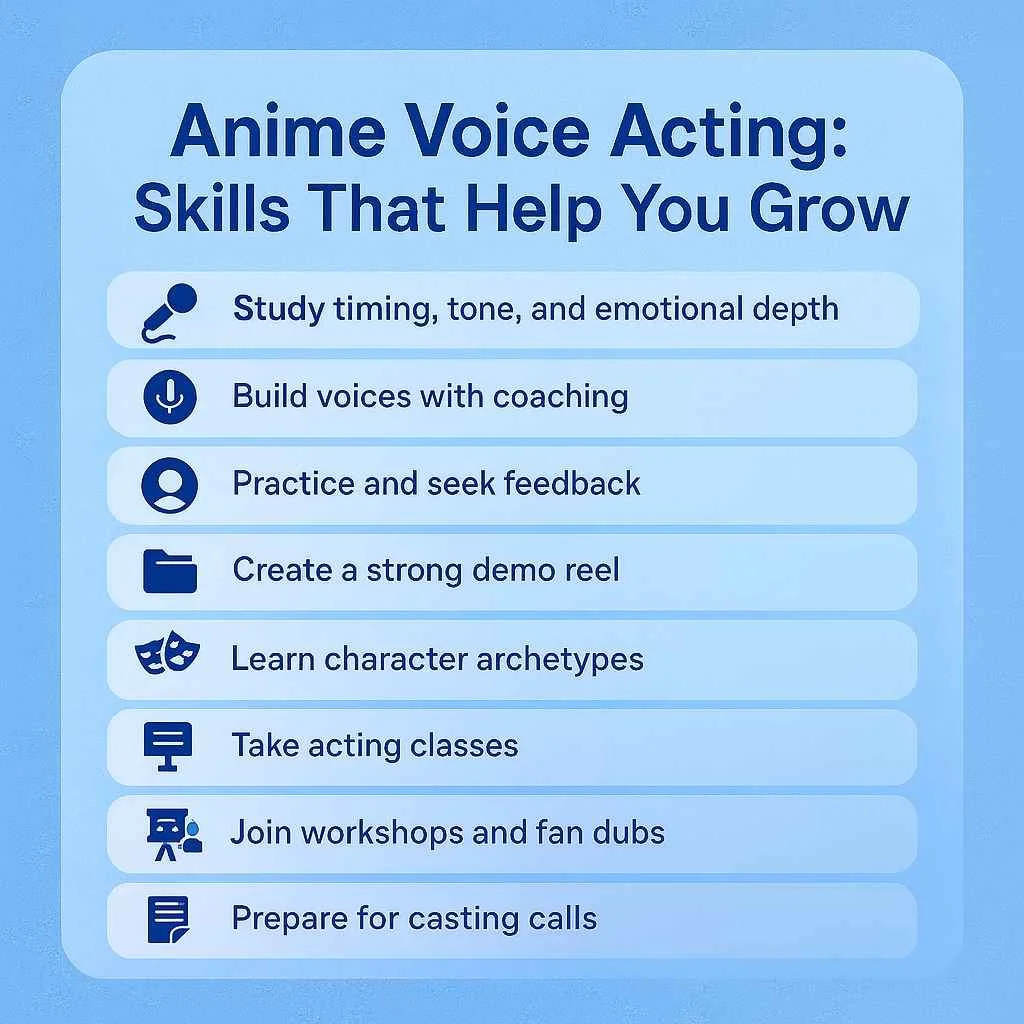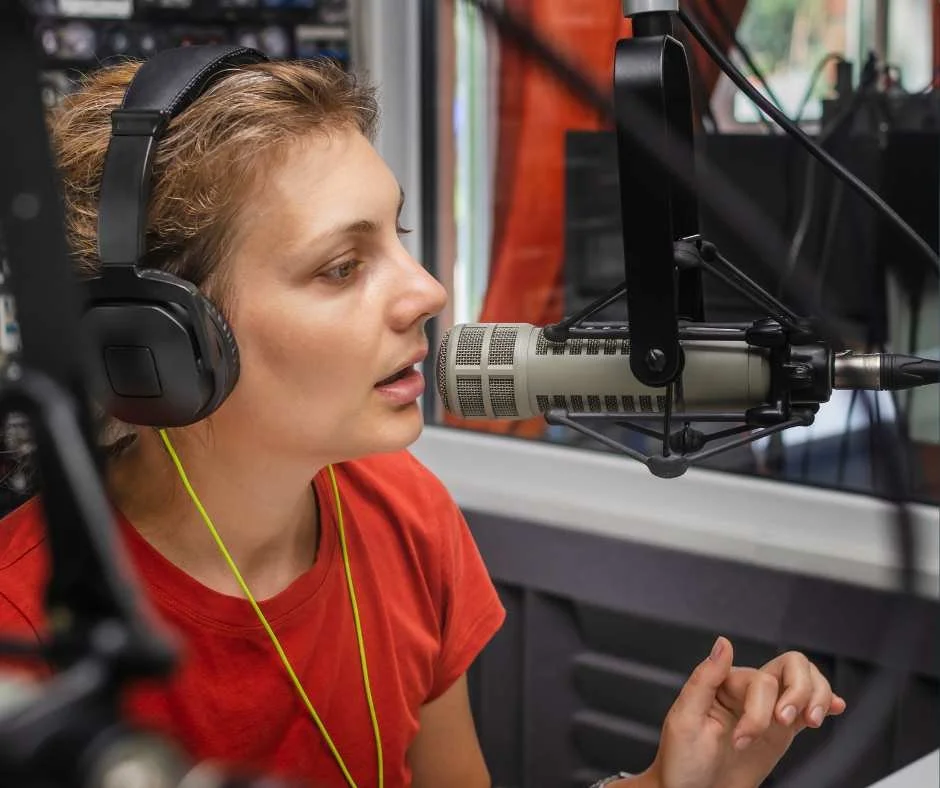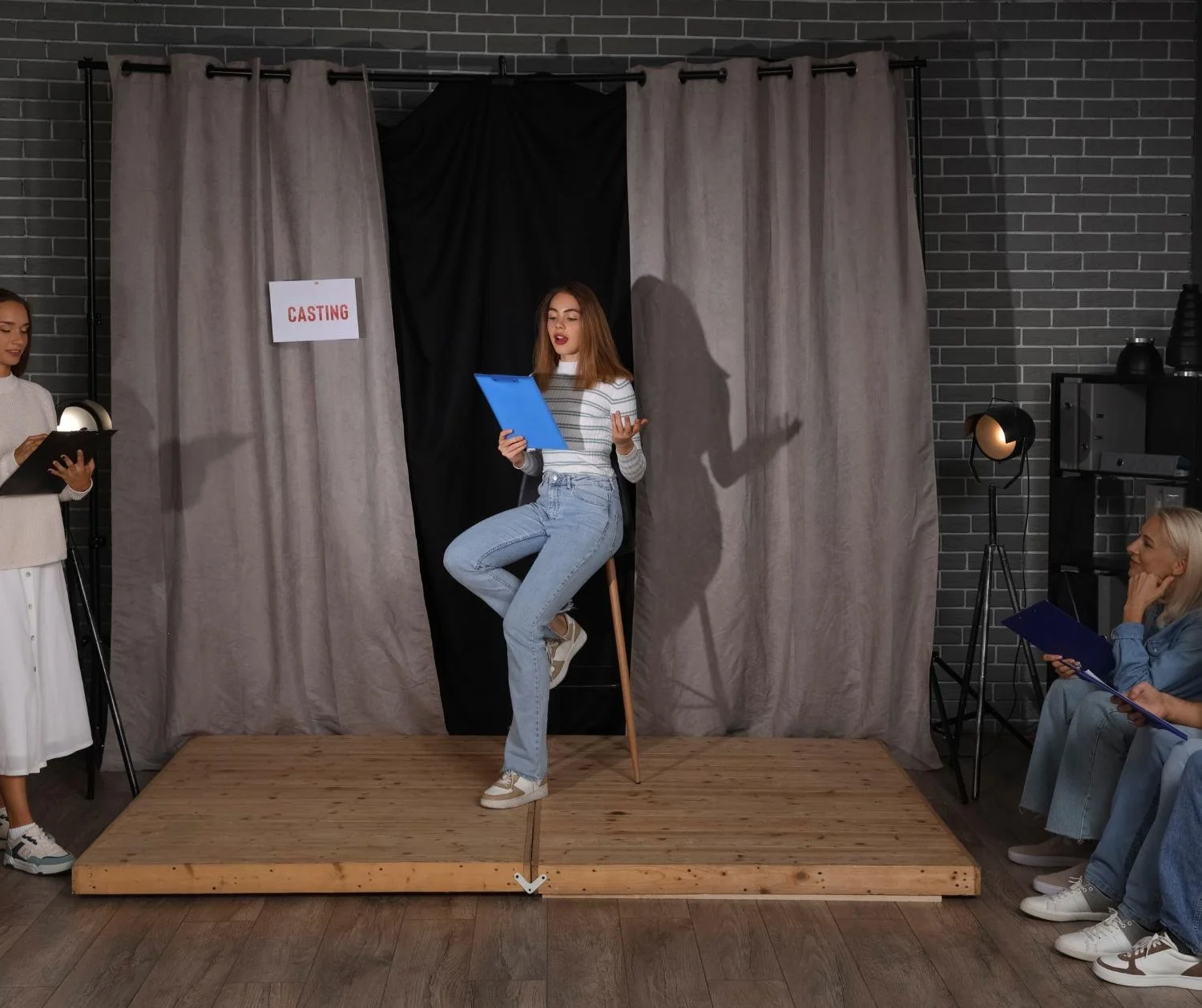Anime Voice Acting: Personalized Voice Coaching That Works
Anime voice acting gives people a way to express emotion, sound, and personality through animated characters. Many adults feel drawn to anime voices because they enjoy anime and want to learn how to shape voices that stand out.
Key Takeaways
Anime voice acting improves when you study timing, tone, and emotional depth in animated characters.
Voice coaching sessions help you build an anime voice that fits a wide range of characters.
Practice, feedback, and continuous learning help you grow in auditions and projects.
A strong demo reel and real connections with fellow voice actors support your growth in the voice acting industry.
Communication and Voice Coaching for Anime Voice Actors
Casting Calls and Auditions for Anime Voice Actors
What Is Anime Voice Acting?
Anime voice acting blends acting, vocal control, and emotional expression to bring animated characters to life. Each performance requires precise timing, clear articulation, and the ability to match the energy and rhythm of a scene.
Many aspiring voice actors begin by studying anime in both Japanese and English to observe how tone, pitch, and pacing shift between calm dialogue and high-intensity moments. This helps them understand how voice alone conveys emotion, movement, and personality.
Successful anime voice actors use steady breath support, expressive range, and detailed attention to timing to fit each animated frame. They collaborate closely with directors and sound engineers to align the voice with the animation’s emotion and pacing. It’s this blend of technical skill and artistic storytelling that makes voices from series like My Hero Academia, Dragon Ball, and Blue Exorcist so memorable to fans.
How Anime Voice Acting Works
The Art of Anime Voice Acting
Anime voice acting combines pitch, tone, timing, and physical control of your voice to create believable, emotionally rich performances. Developing a versatile anime voice means expanding your vocal range safely, learning how to shift pitch without strain, and maintaining a steady tone and breath support through every line.
Emotional depth stems from studying character archetypes, analyzing scripts, and understanding scene pacing, ensuring your delivery aligns with the story’s rhythm.
Building an Anime Voice
A strong anime voice relies on clear tone, healthy breath support, and expressive control. Voice actors train these skills through targeted warm-ups, vowel shaping, and dynamic pitch exercises that help the voice adapt to different emotional states.
Over time, guided practice helps you move smoothly between soft, intimate tones and bold, high-energy expressions, the kind of shifts that give anime performances their dramatic flair.
Understanding Character Archetypes
Every anime character has a distinct sound that reflects their personality and emotional range. Heroes often use brighter, energetic tones that project optimism and drive, while villains might use slower pacing, deeper resonance, or a more deliberate rhythm to convey power or mystery.
Learning to adjust your voice to fit these archetypes allows you to capture the essence of each role and make your performance feel authentic and alive.
Communication and Voice Coaching for Anime Voice Actors
Voice and performance coaching provides anime voice actors with the foundation for confident, expressive voice acting. Through guided practice, you learn how to control pitch, tone, timing, and word choice so your delivery fits each character’s personality and emotion.
Coaching also helps you strengthen vocal endurance and adaptability, skills essential for voice acting when directors change the pacing or energy during a recording session.
Voice Over Acting and Vocal Technique Training
Strong acting technique is at the core of successful anime voice acting. By studying how breath, rhythm, and phrasing shape emotion, you learn to deliver lines that sound natural and alive.
Voice acting training also helps you balance expressive energy with vocal health, allowing you to raise your intensity for fast-paced action scenes or soften your tone for calm or introspective moments without straining your voice.
Voice Over Training Online
Check out our blog on voice over training online for more information.
Workshops, Coaching Sessions, and Fan Dubs
Private coaching sessions, workshops, and fan dubs all provide real-world practice from industry professionals and fellow voice actors. Fan dubs allow you to experiment with timing, projection, and character voices while learning to match your tone to that of existing animation.
Workshops and private coaching provide an additional layer of professional feedback, helping you refine your delivery, expand your emotional range, and prepare for competitive voice acting auditions with confidence.
Casting Calls and Auditions for Anime Voice Actors
Casting Calls and Auditions for Anime Voice Actors
Casting calls outline what studios are looking for in upcoming anime and animation projects, specific vocal tones, ranges, and personality types. Even if you’re not auditioning yet, reviewing casting calls can help you understand what skills directors prioritize in the industry.
Preparing for Anime Casting Calls
Voice and communication coaching can strengthen the skills casting directors most often listen for. You can work with a coach on clarity, breath control, expressiveness, and timing.
During practice, you’ll learn to read scripts with consistent rhythm and emotional precision, adjust your pitch to match different characters, and project confidence through your voice. Watching sample scenes or anime clips can also help you study pacing and inflection before recording your own lines.
Working With Directors for Anime Dubbing
When recording anime dubbing, directors focus on how well your voice fits the animation’s rhythm and emotional tone. Communication coaching helps you adapt quickly to direction by learning to take feedback, refine your delivery, and sustain vocal energy across multiple takes. The goal is to maintain clear, expressive speech while syncing emotion, timing, and breath with every scene so the character feels natural and alive.
Frequently Asked Questions About Anime Voice Acting
1. How do I start anime voice acting?
You start anime voice acting by learning how to shape pitch, timing, and emotion. Many adults begin by watching anime and studying how voices shift from scene to scene.
Acting classes help build emotion and timing for animated characters. Workshops and fan dubs also help you practice before you try auditions.
2. How do I become an anime voice actor?
You become an anime voice actor by building your vocal range and recording a strong demo reel. These steps show directors how you sound across different characters.
You can look for casting calls on industry websites to test your skills. Coaching sessions help you improve tone, timing, and confidence.
3. What skills do anime voice actors need?
Anime voice actors need steady timing, emotional depth, and strong control of their vocal cords. These skills help you match animation and scene pacing.
Clear speech helps each line stay easy to hear. Practice enables you to build these skills over time.
4. How do I build an anime voice?
You build an anime voice by studying character types and practicing tone changes. Many adults record lines to test how their voice fits different characters.
Warm-ups help protect your vocal cords, and steady practice builds strength and tone control. Voice coaching sessions provide you with feedback that helps you improve faster.
5. How do casting calls work for anime?
Casting calls for anime show you the voices, tones, and character needs the studio wants. You record lines that match those needs and send them to directors for review.
Many calls include short scripts with clear personality traits. A clear voice and steady timing help you stand out.
How Connected Speech Pathology Can Help
Connected Speech Pathology provides personalized online coaching for individuals seeking to refine their anime voice-acting skills. Our voice, performance, and communication coaches help you refine tone, timing, clarity, and word choice so your voice can adapt to a wide range of anime characters and styles.
Through individualized feedback, you’ll learn techniques to expand your vocal range, express emotion with precision, and maintain vocal health during long recording sessions. Voice and communication coaching sessions also focus on performance habits that support success in auditions, anime dubbing, and collaboration with directors and other voice actors.
With professional guidance and structured practice, you’ll build the control and confidence needed to deliver authentic, expressive performances that stand out in the world of anime voice acting.
Summary
Anime voice acting blends sound, emotion, and character performance in a creative way. People learn this style by training their tone, timing, and vocal cords with steady practice. Coaching sessions, acting classes, and fan dubs help you grow at a steady pace.
Many adults enjoy this path because anime voices convey strong emotions and personalities. With regular practice, your voice can support animated characters that fans remember.
About the Author
Allison Geller is a communication coach, speech-language pathologist, and founder of Connected Speech Pathology, an international online practice providing professional communication coaching and speech therapy for children, teens, and adults. With more than two decades of experience, she has worked in medical and educational settings, published research on aphasia, and leads a team of specialists helping clients improve skills in public speaking, vocal presence, accent clarity, articulation, language, fluency, and interpersonal communication.









